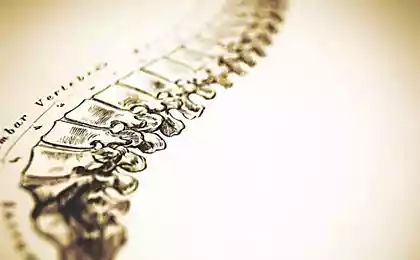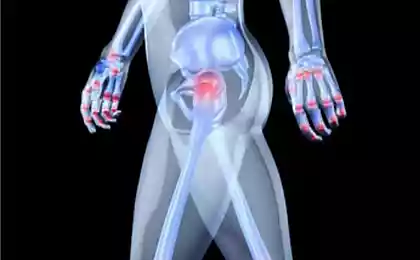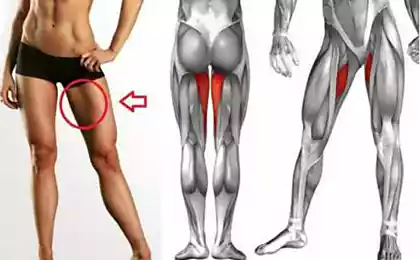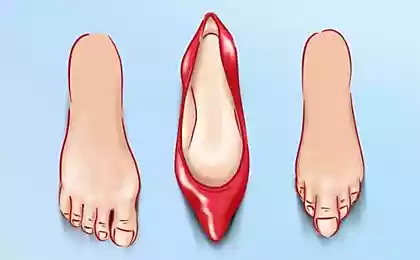631
To cure Hallux Valgus, "bone" without the surgery POSSIBLE!
Why the big toe goes inside?
The position of the big toe (hereinafter BPS) depends on the balance of tone of the muscles-antagonists: adductor and abductor BPS. On the inner side of the foot, between the heel and tibia, the tendon is the cord. Through it passes the heel nerve, which defines the nutrition and tone of the muscle, the outlet of the BFP.
There are many factors under the influence of which is pinched calcaneal nerve, and muscle, abductor BPS, loses its tone and becomes weak. The degree of weakness of this muscle depends on the force with which her antagonist of adductor muscle will win over BPS. As a result of this process, the foot gradually deform, and in extreme muscle weakness, outlet BPS, transverse arch falls, and formed by transverse flat feet.
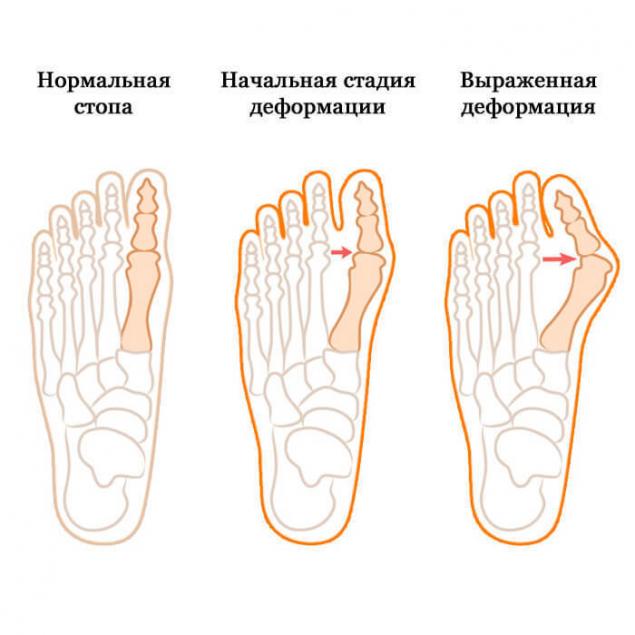
Why are clamped calcaneal nerve?
The fabric tension in the tendon strand (tight between the heel and tibia) tightens like a noose, the nerve under the following circumstances:
— when inward twisting of the tibia;
— when the outer heel or inner lowering of the talus;
— in case of violation of venous and lymphatic outflow from the inner heel region;
— the combination of the above reasons.
Why curled inward tibia?
Because it twists the fascia Lata, which falls on the side of the middle wing of the pelvis and then over the hip and knee joints to the tibia.
Why fascia Lata is having such an impact on the tibia?
Because the correct position of this fascia is determined by the balance of tone of gluteus Maximus and the muscles that bend the fascia of the thigh. In the case where the gluteus Maximus muscle loses its tone, broad fascia of the thigh moves forward under the influence of the other muscles, thus twisting the tibia inwards.
Why becomes weak gluteus Maximus?
1. The gluteus Maximus is associated with the reproductive organs especially uterus in women and prostate in men. Diseases of these organs directly affect the tonus of the muscles. For example, if the patient is observed uterine fibroids, respectively, the gluteus Maximus she loses tone. It should be noted that in case of removal of the uterus, this muscle strong will never become.
2. When triggered, the reflex. Weakness of the muscles of the cervical-occipital transition always causes weakness of big gluteal muscles.
3. In chronic pathological tension in the sacrum gluteus Maximus muscle is weakened at the point of attachment to him. This problem, for example, can arise as a result of birth trauma damage to the sacrum women head born child. For this reason, women who suffer from Hallux Valgus disease more often than men.
4. A lack of vitamin E in the body.
5. The voltage of the coccyx and the pelvic diaphragm because of injury or chronic fear.
6. When the disease of the hip joints.
7. In chronic radicular syndrome S1.
Almost all of the above cases, because of the large gluteal muscles, you can recover the techniques of manual medicine.
What other reasons can influence the displacement of the broad fascia of the thigh forward?
The twist of the wing inside the pelvis for the following reasons:
1. Rough seam on the belly right after appendectomy — Hallux Valgus appears to the right.
2. Rough seam in the middle of the abdomen — bilateral Hallux Valgus.
3. Adhesions in the pelvis.
4. Tension of oblique abdominal muscles as unilateral and bilateral.
5. Simultaneous weakness of the muscles of the abdomen and weakness of big gluteal muscles.
For all the reasons except the last, well exposed to the methods of manual medicine.
Why the heel is turned outward?
1. Chronic stress of the gastrocnemius and soleus muscles causes shortening of the Achilles tendon. To the touch it becomes painful, and the skin over it changes color from sticking it to the tendon. Cause long — term stress- the constant anxiety, or the patient lives in a constant stress.
These muscles will always react to stress the first manifestation of underlying ancient reflex "to escape or catch up." The patient, who lives in constant anticipation of bad events, tense and can't relax, will suffer Hallux Valgus. It is typical for people perceiving the surrounding world is hostile. Their motto in life — " all life in the struggle for a place under the sun."
And you just have to love this world, then will come the trust and will not have to strain.
2. Prolonged wearing of shoes with high heels also cause shortening of the Achilles tendon. Since this habit is characteristic of women, they suffer.

3. The weakness of direct eye muscles causes a reflex DC voltage of calf muscles and shortening of the Achilles tendon.
4. The combination of the above reasons.
Why descends the talus?
The position of the talus have a strong influence the internal muscles of the lower leg. In their weaknesses they cease to maintain the internal portion of the bone, and it falls inside. The result stretches the tendon and the heel cord is clamped nerve.
Why are inner calf muscles become weak?
The main reason is the deep fear, depression life. Such a patient constant heaviness and fatigue in the legs. Disturbed venous and lymphatic flow from the feet and shins, on the inside of the foot, near the heel appear small dilated wreaths — there is calcaneal nerve.
Other causes of weakness of these muscles:
Why disturbed lymphatic and venous outflow from the foot?
The outflow of lymph and blood from the foot passes through the soleus muscle, deep muscles of the lower leg. And up through the popliteal region, the thigh muscles, papertowel ligament. Even up through the pelvis, under the peritoneum, under the liver and the diaphragm via the phrenic. If at some level, there is the obstacle to that outflow, it is immediately reflected on nevadanet tissue around the nerve in the foot. If swelling becomes severe, the calcaneal nerve disrupts its function, and muscle, abductor BPS, it becomes weak. If this problem becomes constant, it is formed Hallux Valgus.
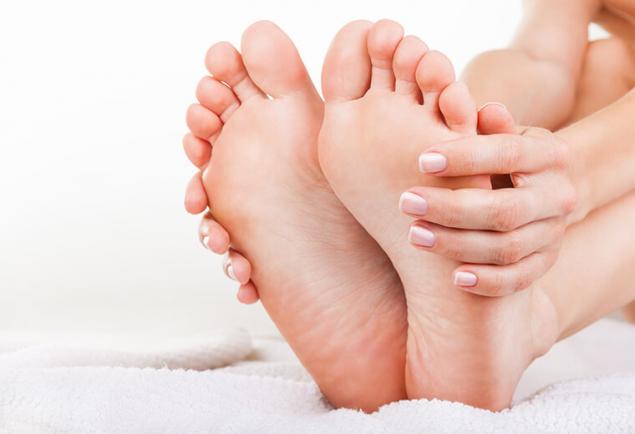
What causes the development of Hallux Valgus?
1. The so-called "climacteric hump" and the withdrawal of the blades forward and down will activate the muscle chains, which twist the leg inward. Reason — severe emotional distress — neviplachennie grief, sadness. Fatigue life. The absence of love.
2. Care the costal arch (usually right) forward and down. The reason is the suppression of resentment and anger. In these patients, "bone" is always on the left and often hurts especially at night when there is no load on the foot. Increased pain is always associated with a reaction of resentment, but patients usually this relationship don't want to see until they point to her doctor.
3. The suppression of crying or hurt feelings, and anger causes an imbalance of the muscles of the tongue and the hyoid bone, which results in muscle chains to the internal twist of the legs left or right and development unilateral Hallux Valgus.
4. Torsion of the ligaments of the knee joint (for various reasons), which causes the internal twisting of the tibia.
5. The consequences of fracture of foot, tibia, femur, metatarsal bones and of the pelvis causing internal torsion of the lower limb.
6. Deep cuts the inner arch of the foot or the leg muscles.
What aggravates valgus deformation of the big toe?
1. The longitudinal flat feet.
2. Hallux valgus.
3. Transverse platypodia, a continuation of which is the development of Hallux Valgus.
4. Intraosseous strain in the metatarsal and shortening.
Why rise 2-3-4 toes with Hallux Valgus?
In chronic stress the short head of the muscle, leading BPS, the action of the flexor of the toes constrained, and released the tension of the antagonist — short extensor of the toes that starts at the bottom of the fibula. The bone in this place becomes painful, the skin dystrophic process. This place is easily determined by touch.
Why is the expansion of the "bone" with Hallux Valgus?
The metatarsal bone of BPS becomes between a rock — always oppressive to it the proximal phalanx of the BPS, and the anvil — bones of the foot. Aggravates the event of joining the forces of the flexor and extensor of the big toe. When the finger is in place, the vector of their exposure is along the axis of the BPS, the displacement of the finger inside the force vector of these muscles goes to the head of the metatarsal bone of BPS.
This pressure causes change in the internal architecture of the bone and leads to its shortening and expansion of its articular part, where often develop osteoporosis.
So maybe still to solve the problem of Hallux Valgus surgical technique?
Of course, here possible surgical intervention, but soon after that there will be a constant pain when walking. The operation removes not the cause, but only a consequence. After surgery, the metatarsal support area of BPS is reduced, in addition, with Hallux Valgus, the center of gravity is shifted forward. Thus, the weak support will be sore and the patient will be limited in movement.
Also the body will perceive the operation as an injury, and will include compensatory muscle chains, which will lead sooner or later to a breakdown of adaptation in any place of the body from head to toe. Such as chronic pain in the lumbar region, neck or hip joint.
The treatment is carried out in stages:
Stage 1 — in the upper zones are removed all the problems that have led to the development of Hallux Valgus. Sometimes it takes a long time when uterine fibroids, adhesive process in the pelvis, hip and emotional problems (unconscious resistance to the treatment of the patient).
Stage 2 — work on the restructuring involved in the process of bone intraosseous techniques of manual therapy.
If the cause is found correct, then already at the first stage of treatment, the disease begins to recede. In this period it is necessary to visit the doctor 2 times a week.
In the second stage of the correction process of self-healing intraosseous techniques. There's enough to see already times a week or every two weeks.
Duration of treatment varies from two to six months depending on the complexity of the patient. It is clear that the duration of treatment of the patient who has a combination of causes will be more.
How to behave as a patient during treatment?
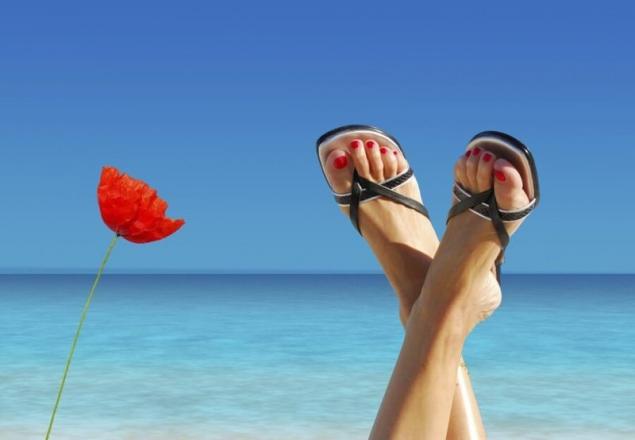
The patient needs to be patient and not fussy. The vanity is the enemy of the therapeutic process. You should follow the advice of a doctor in physical therapy, and, if appropriate instructions, to take medication and exercise physiotherapy.
Some patients will have to reconsider their views on life. Unfortunately, not all ready, because coming to the doctor, patients think they will cure only a finger. Hallux Valgus is a vivid external manifestation of muscular disorganization of the whole body, so treatment is throughout the body.
Each patient is unique and has its own reasons for the development of the disease, so the treatment program to each individual patient. The body's response to treatment in each patient is different. The worst responders to treatment people anxiety warehouse, fearful, distrustful and depressed life.
In some cases, the chances of a cure by the methods of manual medicine minimum?
Hopeless is the treatment of patients:
Hopeless also to treat pretentious and vain patients — they stop the healing process midway, demanding instant results.
Also interesting: the Underlying causes of diseases: jealousy, hatred, pride
How to stop neck pain for 6 minutes
Not coming back after treatment?
If you understand the cause of his illness, that will not happen, as it will no longer be allowed past mistakes.
You have to understand that the body is a single unit, and proof of this is the process of treatment of Hallux Valgus.published
Author: Alexander Smirnov
P. S. And remember, only by changing their consumption — together we change the world! ©
Source: www.facebook.com/photo.php?fbid=968813516511062&set=gm.1093487114029534&type=3&theater
The position of the big toe (hereinafter BPS) depends on the balance of tone of the muscles-antagonists: adductor and abductor BPS. On the inner side of the foot, between the heel and tibia, the tendon is the cord. Through it passes the heel nerve, which defines the nutrition and tone of the muscle, the outlet of the BFP.
There are many factors under the influence of which is pinched calcaneal nerve, and muscle, abductor BPS, loses its tone and becomes weak. The degree of weakness of this muscle depends on the force with which her antagonist of adductor muscle will win over BPS. As a result of this process, the foot gradually deform, and in extreme muscle weakness, outlet BPS, transverse arch falls, and formed by transverse flat feet.

Why are clamped calcaneal nerve?
The fabric tension in the tendon strand (tight between the heel and tibia) tightens like a noose, the nerve under the following circumstances:
— when inward twisting of the tibia;
— when the outer heel or inner lowering of the talus;
— in case of violation of venous and lymphatic outflow from the inner heel region;
— the combination of the above reasons.
Why curled inward tibia?
Because it twists the fascia Lata, which falls on the side of the middle wing of the pelvis and then over the hip and knee joints to the tibia.
Why fascia Lata is having such an impact on the tibia?
Because the correct position of this fascia is determined by the balance of tone of gluteus Maximus and the muscles that bend the fascia of the thigh. In the case where the gluteus Maximus muscle loses its tone, broad fascia of the thigh moves forward under the influence of the other muscles, thus twisting the tibia inwards.
Why becomes weak gluteus Maximus?
1. The gluteus Maximus is associated with the reproductive organs especially uterus in women and prostate in men. Diseases of these organs directly affect the tonus of the muscles. For example, if the patient is observed uterine fibroids, respectively, the gluteus Maximus she loses tone. It should be noted that in case of removal of the uterus, this muscle strong will never become.
2. When triggered, the reflex. Weakness of the muscles of the cervical-occipital transition always causes weakness of big gluteal muscles.
3. In chronic pathological tension in the sacrum gluteus Maximus muscle is weakened at the point of attachment to him. This problem, for example, can arise as a result of birth trauma damage to the sacrum women head born child. For this reason, women who suffer from Hallux Valgus disease more often than men.
4. A lack of vitamin E in the body.
5. The voltage of the coccyx and the pelvic diaphragm because of injury or chronic fear.
6. When the disease of the hip joints.
7. In chronic radicular syndrome S1.
Almost all of the above cases, because of the large gluteal muscles, you can recover the techniques of manual medicine.
What other reasons can influence the displacement of the broad fascia of the thigh forward?
The twist of the wing inside the pelvis for the following reasons:
1. Rough seam on the belly right after appendectomy — Hallux Valgus appears to the right.
2. Rough seam in the middle of the abdomen — bilateral Hallux Valgus.
3. Adhesions in the pelvis.
4. Tension of oblique abdominal muscles as unilateral and bilateral.
5. Simultaneous weakness of the muscles of the abdomen and weakness of big gluteal muscles.
For all the reasons except the last, well exposed to the methods of manual medicine.
Why the heel is turned outward?
1. Chronic stress of the gastrocnemius and soleus muscles causes shortening of the Achilles tendon. To the touch it becomes painful, and the skin over it changes color from sticking it to the tendon. Cause long — term stress- the constant anxiety, or the patient lives in a constant stress.
These muscles will always react to stress the first manifestation of underlying ancient reflex "to escape or catch up." The patient, who lives in constant anticipation of bad events, tense and can't relax, will suffer Hallux Valgus. It is typical for people perceiving the surrounding world is hostile. Their motto in life — " all life in the struggle for a place under the sun."
And you just have to love this world, then will come the trust and will not have to strain.
2. Prolonged wearing of shoes with high heels also cause shortening of the Achilles tendon. Since this habit is characteristic of women, they suffer.

3. The weakness of direct eye muscles causes a reflex DC voltage of calf muscles and shortening of the Achilles tendon.
4. The combination of the above reasons.
Why descends the talus?
The position of the talus have a strong influence the internal muscles of the lower leg. In their weaknesses they cease to maintain the internal portion of the bone, and it falls inside. The result stretches the tendon and the heel cord is clamped nerve.
Why are inner calf muscles become weak?
The main reason is the deep fear, depression life. Such a patient constant heaviness and fatigue in the legs. Disturbed venous and lymphatic flow from the feet and shins, on the inside of the foot, near the heel appear small dilated wreaths — there is calcaneal nerve.
Other causes of weakness of these muscles:
- the consequences of fractures of the Shin bones
- torsion of the interosseous membrane of the leg,
- chronic tension of the pelvic diaphragm.
Why disturbed lymphatic and venous outflow from the foot?
The outflow of lymph and blood from the foot passes through the soleus muscle, deep muscles of the lower leg. And up through the popliteal region, the thigh muscles, papertowel ligament. Even up through the pelvis, under the peritoneum, under the liver and the diaphragm via the phrenic. If at some level, there is the obstacle to that outflow, it is immediately reflected on nevadanet tissue around the nerve in the foot. If swelling becomes severe, the calcaneal nerve disrupts its function, and muscle, abductor BPS, it becomes weak. If this problem becomes constant, it is formed Hallux Valgus.

What causes the development of Hallux Valgus?
1. The so-called "climacteric hump" and the withdrawal of the blades forward and down will activate the muscle chains, which twist the leg inward. Reason — severe emotional distress — neviplachennie grief, sadness. Fatigue life. The absence of love.
2. Care the costal arch (usually right) forward and down. The reason is the suppression of resentment and anger. In these patients, "bone" is always on the left and often hurts especially at night when there is no load on the foot. Increased pain is always associated with a reaction of resentment, but patients usually this relationship don't want to see until they point to her doctor.
3. The suppression of crying or hurt feelings, and anger causes an imbalance of the muscles of the tongue and the hyoid bone, which results in muscle chains to the internal twist of the legs left or right and development unilateral Hallux Valgus.
4. Torsion of the ligaments of the knee joint (for various reasons), which causes the internal twisting of the tibia.
5. The consequences of fracture of foot, tibia, femur, metatarsal bones and of the pelvis causing internal torsion of the lower limb.
6. Deep cuts the inner arch of the foot or the leg muscles.
What aggravates valgus deformation of the big toe?
1. The longitudinal flat feet.
2. Hallux valgus.
3. Transverse platypodia, a continuation of which is the development of Hallux Valgus.
4. Intraosseous strain in the metatarsal and shortening.
Why rise 2-3-4 toes with Hallux Valgus?
In chronic stress the short head of the muscle, leading BPS, the action of the flexor of the toes constrained, and released the tension of the antagonist — short extensor of the toes that starts at the bottom of the fibula. The bone in this place becomes painful, the skin dystrophic process. This place is easily determined by touch.
Why is the expansion of the "bone" with Hallux Valgus?
The metatarsal bone of BPS becomes between a rock — always oppressive to it the proximal phalanx of the BPS, and the anvil — bones of the foot. Aggravates the event of joining the forces of the flexor and extensor of the big toe. When the finger is in place, the vector of their exposure is along the axis of the BPS, the displacement of the finger inside the force vector of these muscles goes to the head of the metatarsal bone of BPS.
This pressure causes change in the internal architecture of the bone and leads to its shortening and expansion of its articular part, where often develop osteoporosis.
So maybe still to solve the problem of Hallux Valgus surgical technique?
Of course, here possible surgical intervention, but soon after that there will be a constant pain when walking. The operation removes not the cause, but only a consequence. After surgery, the metatarsal support area of BPS is reduced, in addition, with Hallux Valgus, the center of gravity is shifted forward. Thus, the weak support will be sore and the patient will be limited in movement.
Also the body will perceive the operation as an injury, and will include compensatory muscle chains, which will lead sooner or later to a breakdown of adaptation in any place of the body from head to toe. Such as chronic pain in the lumbar region, neck or hip joint.
The treatment is carried out in stages:
Stage 1 — in the upper zones are removed all the problems that have led to the development of Hallux Valgus. Sometimes it takes a long time when uterine fibroids, adhesive process in the pelvis, hip and emotional problems (unconscious resistance to the treatment of the patient).
Stage 2 — work on the restructuring involved in the process of bone intraosseous techniques of manual therapy.
If the cause is found correct, then already at the first stage of treatment, the disease begins to recede. In this period it is necessary to visit the doctor 2 times a week.
In the second stage of the correction process of self-healing intraosseous techniques. There's enough to see already times a week or every two weeks.
Duration of treatment varies from two to six months depending on the complexity of the patient. It is clear that the duration of treatment of the patient who has a combination of causes will be more.
How to behave as a patient during treatment?

The patient needs to be patient and not fussy. The vanity is the enemy of the therapeutic process. You should follow the advice of a doctor in physical therapy, and, if appropriate instructions, to take medication and exercise physiotherapy.
Some patients will have to reconsider their views on life. Unfortunately, not all ready, because coming to the doctor, patients think they will cure only a finger. Hallux Valgus is a vivid external manifestation of muscular disorganization of the whole body, so treatment is throughout the body.
Each patient is unique and has its own reasons for the development of the disease, so the treatment program to each individual patient. The body's response to treatment in each patient is different. The worst responders to treatment people anxiety warehouse, fearful, distrustful and depressed life.
In some cases, the chances of a cure by the methods of manual medicine minimum?
Hopeless is the treatment of patients:
- after removal of the uterus and pelvic organs,
- in coxarthrosis 3 degrees,
- in extensive scarring in the abdomen due to weak muscular corset this area
- in rheumatoid arthritis,
- common in patients with severe osteoporosis.
Hopeless also to treat pretentious and vain patients — they stop the healing process midway, demanding instant results.
Also interesting: the Underlying causes of diseases: jealousy, hatred, pride
How to stop neck pain for 6 minutes
Not coming back after treatment?
If you understand the cause of his illness, that will not happen, as it will no longer be allowed past mistakes.
You have to understand that the body is a single unit, and proof of this is the process of treatment of Hallux Valgus.published
Author: Alexander Smirnov
P. S. And remember, only by changing their consumption — together we change the world! ©
Source: www.facebook.com/photo.php?fbid=968813516511062&set=gm.1093487114029534&type=3&theater
The quirks of the human mind: 8 reasons why you should not trust yourself
Swiss electric car sets acceleration record




